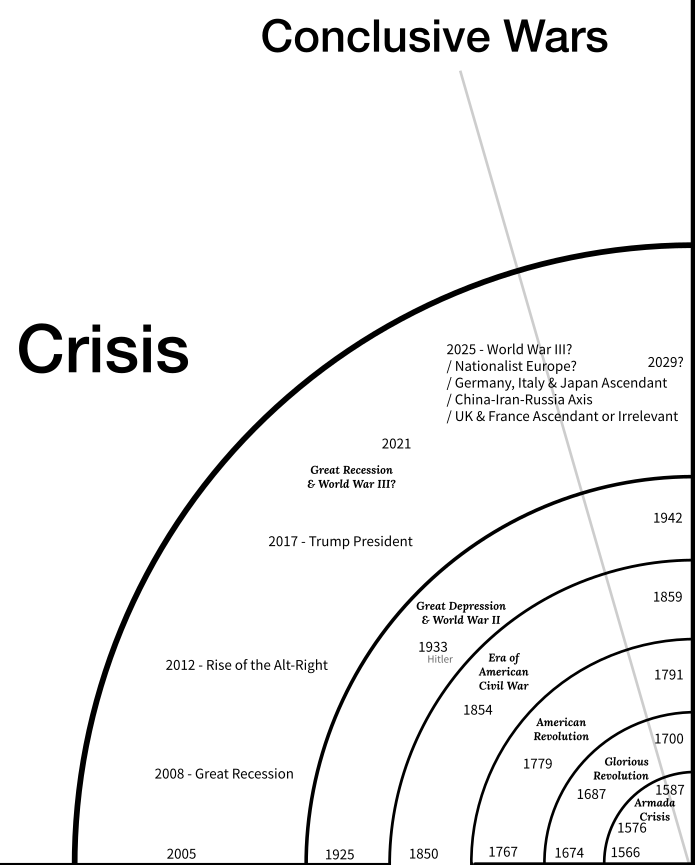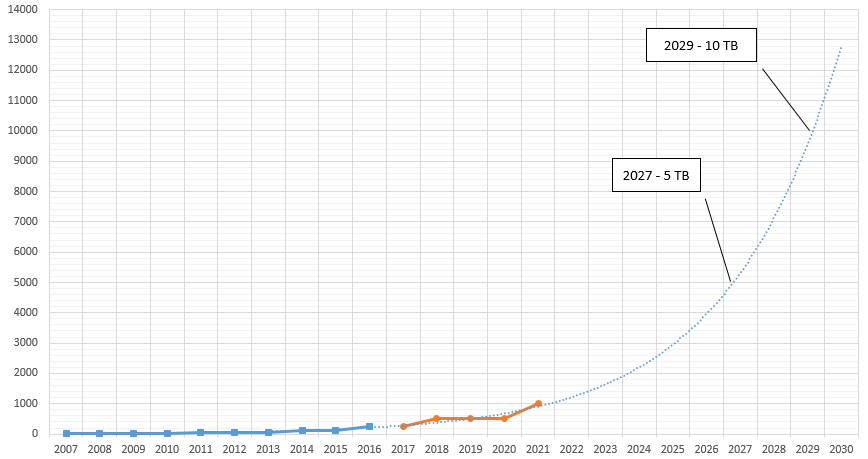I wanted your in depth opinion on a particular observation. Muslims, historically speaking, have been responsible for hundreds and thousands of scientific discoveries. What happened to us? Why are we in the stage we are?
Only 100 years ago, which is just a little more than one human lifetime, the Ottoman Empire was a sovereign Muslim nation that could stand up to any Western power. No Jewish colonizer would have dared to terrorize and massacre Palestinians when the Ottoman Empire was there to protect its citizens.
While many Muslims, including scholars, think that Muslims were always powerful, capable and thriving throughout history until modern times, this is mostly a romantic fairy tale told to console and encourage.
The Crusaders were able to take Jerusalem and other parts of the Levant from the Muslims in 1099 CE and ruled it for nearly 100 years. Where were the great Muslim powers in this time that they couldn’t take it back? The Middle East was a mix of weak and fractured “Muslim” powers, who were only Muslim in name but in general acted like any modern power, using religion to justify their actions while being under the influence and sometimes control of foreign non-Muslim powers.
The current weakness and powerlessness of Muslims is similar to their state during the Mongol invasions. Some Muslims thought the end of the world had arrived, thinking the Mongols were the promised Ya’jooj and Ma’jooj (Gog and Magog) mentioned in the Quran. The Mongols utterly destroyed the Sunni Muslim Khwarezmian Empire which controlled nearly all of Modern Iran, Turkmenistan, Uzbekistan and parts of Afghanistan and Kazakhstan, and which had existed for 150 years, through the wholesale slaughter of men, women and children. After that, they went on to destroy Baghdad and Damascus, although the Abbasid Empire had been in decline for centuries before the Mongols arrived.
On the other side of the Medieval world, Muslims ruled nearly half of Spain for nearly 800 years, until 1492 CE (which is also the year the Americas were discovered). Just as they threw Muslims out of Spain, Christians went on to conquer two continents, spread Christian rule all over them, and eventually built the world’s most powerful nation there.
The Myth of Continuous Power Increase
There is a myth among Muslims that since they belong to God’s chosen religion, they should have been able to establish a globally dominant power that ruled the world forever. But God doesn’t promise us that. He promises that we will be tested:
You will be tested through your possessions and your persons; and you will hear from those who received the Scripture before you, and from the idol worshipers, much abuse. But if you persevere and lead a righteous life—that indeed is a mark of great determination.
God also threatens us with His ability to remove us from power and replace us with others if we do not follow His guidance:
131. To God belongs everything in the heavens and everything on earth. We have instructed those who were given the Book before you, and you, to be conscious of God. But if you refuse—to God belongs everything in the heavens and everything on earth. God is in no need, Praiseworthy.
132. To God belongs everything in the heavens and everything on earth. God suffices as Manager.
133. If He wills, He can do away with you, O people, and bring others. God is Able to do that.
Verse 131 above mention’s God’s warning to the People of the Book. The Old Testament contains many promises by God that if His people disobey, He will abandon them to whatever that may happen to them, and that He will make others dominant over them. In the Book of Deuteronomy (part of the Old Testament, and part of the Torah), prophet Musa (Moses) says:
25 When thou shalt beget children, and children's children, and ye shall have remained long in the land, and shall corrupt yourselves, and make a graven image, or the likeness of any thing, and shall do evil in the sight of the Lord thy God, to provoke him to anger:
26 I call heaven and earth to witness against you this day, that ye shall soon utterly perish from off the land whereunto ye go over Jordan to possess it; ye shall not prolong your days upon it, but shall utterly be destroyed.
27 And the Lord shall scatter you among the nations, and ye shall be left few in number among the heathen, whither the Lord shall lead you.
The Quran, too, mentions prophet Musa saying similar things:
6. Moses said to his people, “Remember God’s blessings upon you, as He delivered you from the people of Pharaoh, who inflicted on you terrible suffering, slaughtering your sons while sparing your daughters. In that was a serious trial from your Lord.”
7. And when your Lord proclaimed: “If you give thanks, I will grant you increase; but if you are ungrateful, My punishment is severe.”
8. And Moses said, “Even if you are ungrateful, together with everyone on earth—God is in no need, Worthy of Praise.”
Our relationship with God is not one where He constantly supports us just because we say we are His nation, unlike some Muslims and many Jews think. Here is the Jewish feminist author Naomi Wolf expressing her surprise at finding out (by reading the Hebrew Bible) that unlike what many Jews think, God does not promise them never-ending support just because they are “His chosen people”:
He never says: "I will give you, ethnic Israelites, the land of Israel." Rather He says something far more radical - far more subversive -- far more Godlike in my view. He says: IF you visit those imprisoned...act mercifully to the widow and the orphan...welcome the stranger in your midst...tend the sick...do justice and love mercy ....and perform various other tasks...THEN YOU WILL BE MY PEOPLE AND THIS LAND WILL BE YOUR LAND. So "my people" is not ethnic -- it is transactional. We are God's people not by birth but by a way of behaving, that is ethical, kind and just. And we STOP being "God's people" when we are not ethical, kind and just.
She is not quite correct when she says “my people” is not ethnic. Jews are God’s chosen, but being chosen does not necessarily mean one is chosen for a good thing. Jews are God’s chosen in that He gave them many scriptures and throughout the centuries continuously sent them new prophets to guide them back to the Straight Path. He chose them for a specific test. Their being chosen is not just a privilege, it is both a privilege and a heavy burden. If they reject God despite being chosen, God sends the most terrible punishments on them, like He has done many times throughout history. Many Jews forget the burden and choose to enjoy the privilege of thinking of themselves as God’s chosen elite.
Our relationship with God is contractual. If we obey, He supports us. If we disobey, He stops supporting us and subjects us to unfriendly powers.
The story of the Jews is a good lesson for us. Many times in their history they were extremely powerful. After they left Egypt, they entered Canaan around 1446 BCE. They disobeyed God when they were about to overtake a city and live in it, so God punished them by having them wander in the desert for 40 years. They finally entered Canaan in 1406 BCE and completely conquered it by 1399 BCE. Once they become a sovereign power, they soon start to do evil, abandoning God, worshiping Baal or the Calf, practicing usury or allying themselves with irreligious foreign powers like Egypt. For this reason, as they rejected and sometimes even killed their prophets, every few generations God would send a powerful foreign power to destroy many of their cities and slaughter many of their people.
When they continued to reject God, He sent Babylon to conquer their lands and sent them into exile for 70 years. After that the Persian emperor, whose empire had conquered Babylon, allowed the Jews to return to their lands and reestablish themselves there. Their story continued the same as before, with them doing evil and being punished for it. In 70 AD, a few decades after they rejected Jesus and tried to kill him, they tried to escape the rule of the Roman empire. In return they had their city of Jerusalem utterly destroyed and hundreds of thousands of Jews killed.

The Arch of Titus, which commemorates the Roman victory over the Jews, among other things, still stands in Rome.
Titus, the Roman commander who was in charge of the Roman victory over the Jews, is supposed to have refused to wear a wreath after the victory, saying that he was only acting as a tool of God’s wrath over the Jews. Perhaps this was God’s punishment on them for their rejecting God’s prophet Jesus.
In Jewish history there is an important historical lesson; that just because a nation associates itself with God and claims to be His people does not mean they will always have God’s support.
Muslim nations have had a history similar to that of the Jews. Many powerful Muslim states have risen and fallen throughout history, and this process is not going to end. If we establish a caliphate like some Muslims dream about, and even if it rules the world for 1000 years, if most of the population abandons Islamic values and Islam becomes largely culture and tradition and not faith, then that caliphate too will fail. God will enable another Mongol invasion, or another invasion by the British and the French, to come and divide their caliphate and do with it as they please.
Christianity’s Place in Islamic History
Just as Islam faded in the Middle East and became little more than cultural tradition and ceremony, Christianity rose in the West. The Christians who conquered the Americas thought they were doing it for God’s sake. They read the Bible daily, they established Biblical law in their colonies, and they braved many dangers in order to establish families, villages and cities in empty and hostile lands.
God’s promise in the Quran came true for them for their deeds:
65. Had the People of the Scripture believed and been righteous, We would have remitted their sins, and admitted them into the Gardens of Bliss.
66. Had they observed/enforced the Torah, and the Gospel, and what was revealed to them from their Lord, they would have consumed amply from above them, and from beneath their feet. Among them is a moderate community, but evil is what many of them are doing.
While it is common for many Muslims to think of Christians as nothing but heathens who should magically disappear now that Islam has come, Christians are as much God’s people as Muslims are, that is, they too have a contract with God, and if they uphold their contract with God, God will uphold His contract with them. If a Christian nation is more faithful, more eager to serve God, and more observant of God’s laws, then we shouldn’t be surprised if God gives them His full support.
This was the case in the Americas and much of Western Europe until 1900 CE. With all of the corruption present, the average person’s actions and thinking were still largely controlled by Christian ideals.
Today, things are different. The West has finally abandoned the religion that made it great. The only reason the West is great today is the momentum of the past. A Muslim may lose hope when they look at the United States and see its immense capacity to dominate and do evil throughout the world. But the United States is already past its prime. It is desperately trying to hold onto its past power, constantly threatening Russia, China and Iran, but incapable of doing anything about them as they continue to rise.
The United States has had a below-replacement fertility rate since the 1970’s. If it wasn’t for their continuous importation of immigrants, their population would have been shrinking by now. A decades-long below-replacement fertility rate is all that is needed to illustrate that a nation is failing.
It is a country’s population that gives a nation its economic, technological and military power, and once the population starts to shrink, its power will decrease, because there will be fewer people to innovate, and fewer people to consume the fruits of these innovations and in this way pay for further innovations. Today the United States can afford to spend hundreds of billions of dollars on military spending every year, and it is this spending that enables various military companies to continue innovating. But as the American tax base and economy both shrink, with this its power to spend will shrink. America is on a trajectory to become the next Portugal, once a global superpower, now almost a complete non-entity (unless it continues to import immigrants, but this cannot go on forever).
One illustration of the continuing fall of the United States is that of the world’s top 15 skyscrapers (those higher than 350 meters) finished in the past 3 years, 10 are in China, and only one in the United States. China continues to rise, the United States continues to stagnate and fall. America’s failing economy has no need for new office buildings, hotels and restaurants, since it already has more than its shrinking economy needs.

The answer to the question of why Muslims are so powerless compared to the West these days is that Islamic history ran into Christian history. Christian power was still rising when it clashed with an Ottoman Empire that was already past its prime, so the Ottomans didn’t stand a chance.
Today, Christian powers too are past their prime, and great change is coming.
The United States is unlikely to become a Portugal any time soon, and if Islam continues to spread, it might change into a new type of superpower without becoming irrelevant.
It should be noted that while China’s rise will probably be a good thing in the short-term, as its rise to power will probably prevent further significant US excesses for the next few decades, once it is firmly established as the world’s most powerful country, it could start acting like the US, forcing every other country to either become a de facto client state or get turned into a war zone.
The Long View of History
Even if Muslims establish a new global superpower that lasts for hundreds of years, it too can eventually fail and get conquered by non-Muslim powers. Imagine if this world continues to exist for the next 100,000 years. The story of Muslims being powerful then weak then powerful again might play out fifty or a hundred times more.
We humans want safety and security. We want to establish Paradise on Earth once and for all and then go on living in it. But that is not the purpose of this world, and dreams of establishing a Paradise on Earth are naive and futile. We are taught over and over again in the Quran that this world is worthless, that it will soon be over, that none of our deeds done in this world will last. The Quranic character Dhul Qarnain shows his appreciation for God’s message when he says the following right after completing building a structure for God’s sake:
He said, “This is a mercy from my Lord. But when the promise of my Lord comes true, He will turn it into rubble, and the promise of my Lord is always true.”
For us Muslims, it is always about the journey, not the destination. It doesn’t matter what we accomplish in this world, because nothing we do will last. Everything we think we can accomplish, if God is really all-powerful, God can accomplish it in an instant if He wants. The point is not accomplishment in itself, the point is to follow God. What matters is the record of our deeds. No matter what we build, no matter how much power we have, we could see it all destroyed tomorrow. This has happened over and over again in history, though sadly we continue to fail to learn the lesson.
Why did God let the Mongols destroy Baghdad and Damascus if our purpose was to continue to gain power, wealth and fame in this world? Why did He let the Ottoman Empire, the last truly sovereign Muslim power, be invaded and destroyed? Why did He not allow the Arab powers to defeat Israel during their multiple wars?
Because this world is a test. It is not our purpose to build Paradise on Earth. Our purpose is khilafah, literally “to be stewards”. We are stewards of the earth. Our purpose is to take care of it by enjoining good and admonishing against evil, so that humanity continues, and so that the the earth does not become entirely corrupted.
A steward takes care of a farm until the owner returns, continuing the running of the farm as best as they can. It is the owner’s business what they do with the farm. In the same way, our job in this world is to continue be God’s stewards, God’s agents for good in this world, but it is His business what He does with this world, and whether He gives us power or takes it away from us. All that we can say is, “We hear and we obey.”
We are not seekers after power. The Prophet (peace be upon him) did not seek power, it was given to him. Neither did any of the righteous Rashidun caliphs. We do not seek to establish global dominance, or to carry out global war. Our job is to be God’s stewards, to walk on the Straight Path.
Being on the Straight Path does not require gaining power, and in fact the seeking of power is directly opposed to it, for the seeking of power always requires that one abandon one’s moral integrity. This is the story of every political party that starts out with high moral ideals only to become a nest of corruption and evil.
It is God who gives us power if we deserve it, and if the time is right, for His own purposes, and as long as it pleases Him, until He takes it away from us. As for us, we must be thankful and content throughout all of this:
No, but worship God, and be among the thankful ones.
It is God who manages history for us. We are not in charge, God is.
No calamity strikes except by God’s permission. Whoever believes in God, He guides his heart. God is Aware of everything.
No calamity occurs on earth, or in your souls, but it is in a Book, even before We make it happen. That is easy for God. That you may not sorrow over what eludes you, nor exult over what He has given you. God does not love the proud snob.
God does not change the condition of a people until they change what is within themselves. And if God wills any hardship for a people, there is no turning it back; and apart from Him they have no protector.
God has promised those of you who believe and do righteous deeds, that He will make them successors on earth, as He made those before them successors, and He will establish for them their religion—which He has approved for them—and He will substitute security in place of their fear. They worship Me, never associating anything with Me. But whoever disbelieves after that—these are the sinners.
Our job is to do good wherever we find ourselves, to worship God, to be kind and just, to follow His commandments as best as we can, and it is God who will establish us on Earth when He pleases:
God has promised those of you who believe and do righteous deeds, that He will make them stewards on Earth, as He made those before them stewards, and He will establish for them their religion—which He has approved for them—and He will substitute security in place of their fear. They worship Me, never associating anything with Me. But whoever disbelieves after that—these are the sinners.
We can, of course, be political activists and social critics. We can constantly work toward social justice and the lifting of poverty. But instead of doing these by seeking power first, we do them without seeking power. We do what is right and just and kind toward everyone, and God, if He wishes, can give us power any time He wants.
Ibn al-Jawzi says in his Sayd al-Khaatir (“Quarry of the Mind”):
I reflected upon the envy that exists among scholars, and saw that its source is the love of the worldly life, because the scholars of the afterlife engage in love and do not envy others. What separates the two groups is that the scholars of the worldly life seek power and leadership in it, and they love to accumulate wealth and praise, while the scholars of the afterlife live in seclusion from these things, they fear them and have mercy toward those who are being tested by them.
Truly good and kind people, who fear God and take the afterlife seriously, do not seek power in my experience. Sometimes the right situation arises for a good person to rise and become powerful, as it happened with Saladin. Saladin wasn’t a revolutionary who grabbed power or a politician. He became powerful as part of his job as a military commander, and one thing led to another until he became a powerful ruler.
The writer Frank Herbert says the following in Chapterhouse: Dune, and I find them true from all that I have seen:
All governments suffer a recurring problem: Power attracts pathological
personalities. It is not that power corrupts but that it is magnetic to the
corruptible.
Power attracts the corruptible. Suspect all who seek it.
Scientific vs. Divine Explanations for Islam’s Decline: Islam, Christianity and Indo-European Genes
A mistake many people make, both religious and irreligious, is that when they discover a scientific explanation for something, they start to think that it means that thing is not from God. But it is a principle of God that He will never allow us to have direct evidence of His existence, therefore when God does something, it is always through scientific means, or He makes it appear to be that way. God will not carry out miracles that can be recorded and published on YouTube. The only time that we will have direct proof of the existence of God and the rest of the Unseen is at the end of the world. When the pagans requested that they see an angel before they believe in God, God’s reply was this:
Had We sent down an angel, the matter would have been settled, and they would not have been reprieved.
If we ever had direct evidence of God’s existence, then there would be no need for faith in God. God does not want that to happen, therefore everything that happens to us must have logical scientific explanations. We can examine Islamic history to find out where things went wrong. But even if we discover every single cause and try to cure it, our success is not guaranteed.
The divine reason for the fall of Muslims is that they abandoned Islam in their hearts, while the scientific reason might be the demographic collapse of the Persian population after the endless flood of Turkic and Mongol attacks that devastated the great Persian-speaking cities of Central Asia (over 90% of Islam’s greatest scholars, thinkers and scientists came from these cities). The divine reasons precede the scientific reasons. If we disobey God, God will bring about logical and scientifically-explainable reasons for our destruction. And if we obey God, and carry out our stewardship in the best manner possible, God will inspire us toward whatever will give us success and power in this world.
Conclusion
As Muslims, our goal in life is not to acquire power, glory or supremacy in this world. Our goal is not to establish Paradise on Earth. We can appreciate technological and scientific accomplishments, and we can work toward them as part of our stewardship on Earth, but we must never lose sight of the fact that ultimately, everything we do is meant to serve God, and that a day will come when all of our worldly works will be destroyed as if they never existed.
In this world, we are stewards of a temporary farm, a farm whose Owner has promised to destroy in the end. We must never get attached to this farm, or seek its improvement or power over it as a goal in itself. We must never get attached to the idea of establishing a global power. Even if we establish one, it too can come and go like every other Muslim power in history. History will continue going in cycles, Muslims will rise to power, fall, and rise again. The only people who achieve success are those who fear God and serve Him in the best way possible. It is only the record of our deeds which lasts forever, everything else is temporary.
If Muslims are weak today, look again in 500 years, and they may be the strongest and most technologically advanced power on Earth. Look again in 1500 years, and they may again be weak, oppressed and backward. It is God who gives and God who takes. If we are thankful and obedient, He will increase us and improve our station in life, and if we are ungrateful, He can always take it all away from us and subjugate us to others.
Note that I am not saying that Muslims should turn their backs on science and progress. I love science and technology and eagerly follow its news, and I look forward to Muslim societies catching up to Western ones. Last year Muslim-majority Malaysia overtook Japan in its scientific research output per capita, as the graph below shows, and that is a very hopeful sign for the growth of scientific knowledge among Muslims:
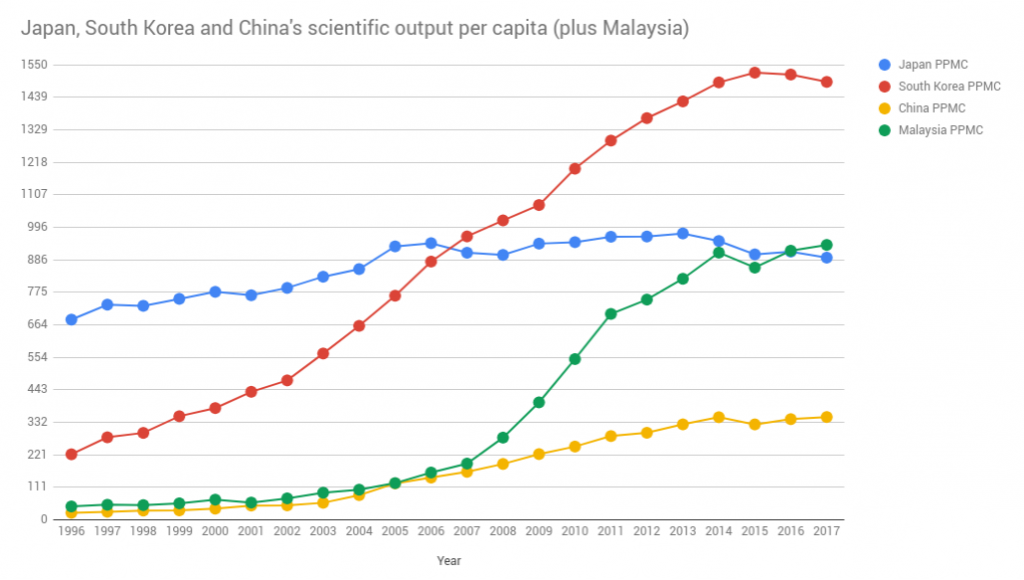
The graph shows the number of scientific research papers published by each country divided by its citizens in millions. In 2017 Malaysia produced 936 papers per million citizen, while Japan produced 892.
Other Muslim nations have shown tremendous growth in scientific research as well. Egypt today produces five times more scientific and scholarly research compared to a mere 15 years ago. Iran is on track to catch up with European countries before 2030. These are things to look forward to, but we should not lose sight of the bigger picture.







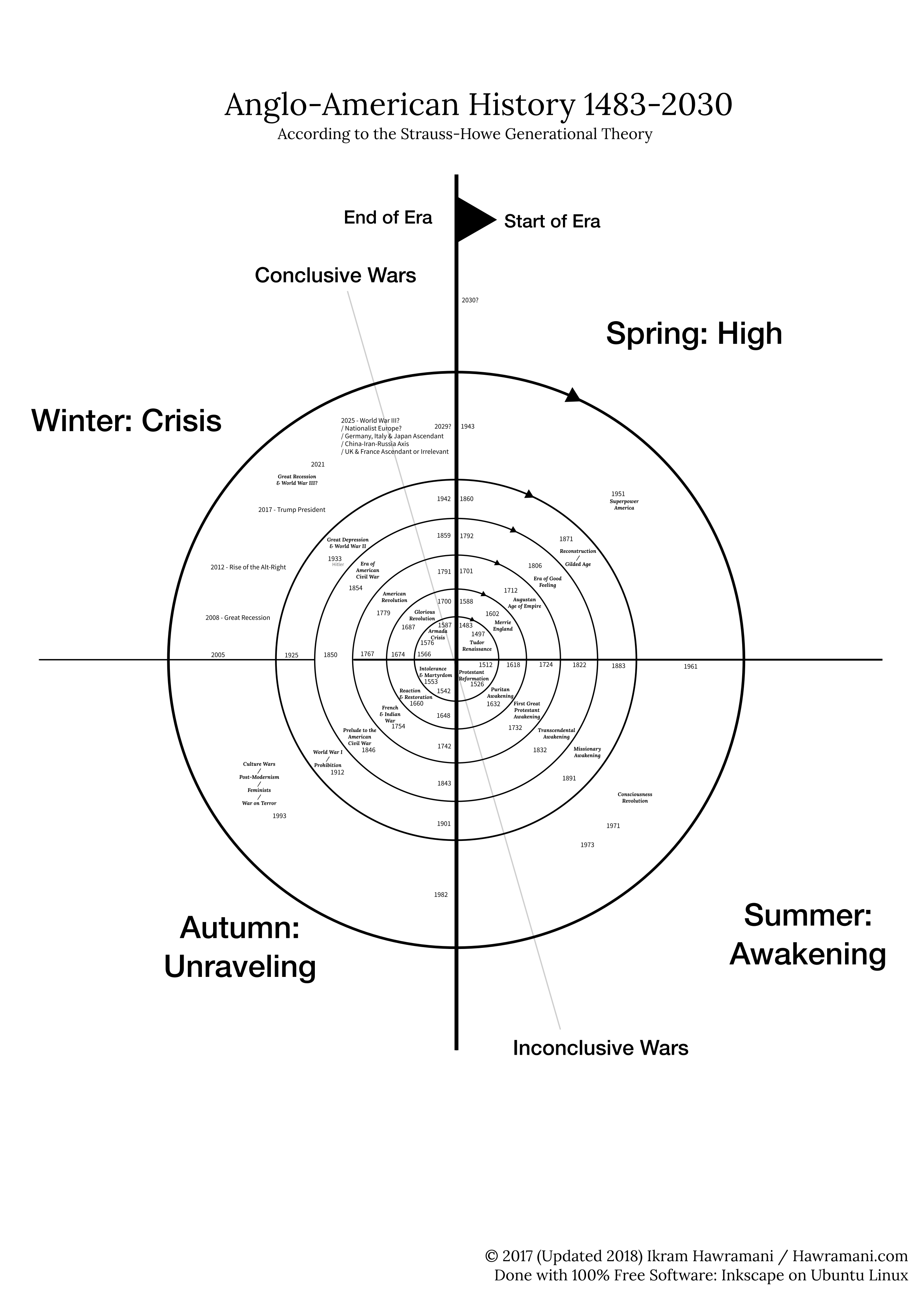
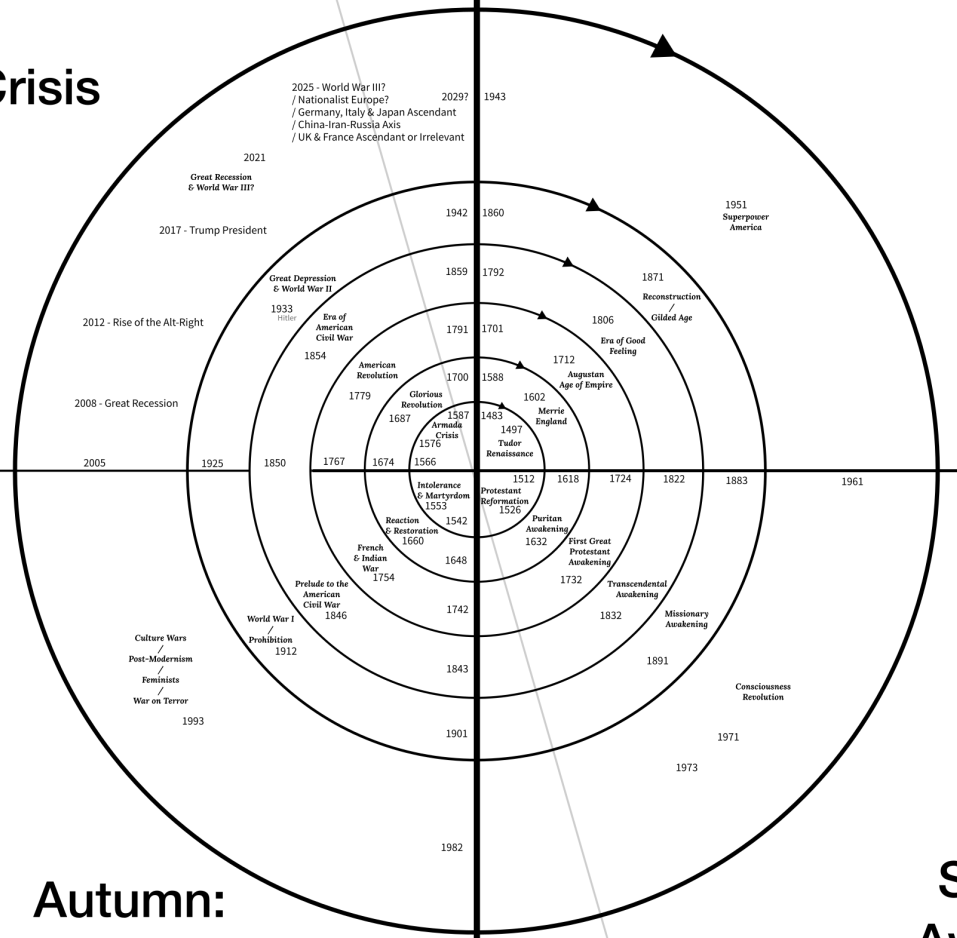 The “saeculum” is the word that Strauss-Howe use for each circle of the chart above, four seasons together make one saeculum. A saeculum is generally the length of one human life time, and its regularity has been noted since ancient times. We are currently living at the end of the saeculum that started in 1943, and which will probably end sometime between 2025 and 2035.
The “saeculum” is the word that Strauss-Howe use for each circle of the chart above, four seasons together make one saeculum. A saeculum is generally the length of one human life time, and its regularity has been noted since ancient times. We are currently living at the end of the saeculum that started in 1943, and which will probably end sometime between 2025 and 2035.